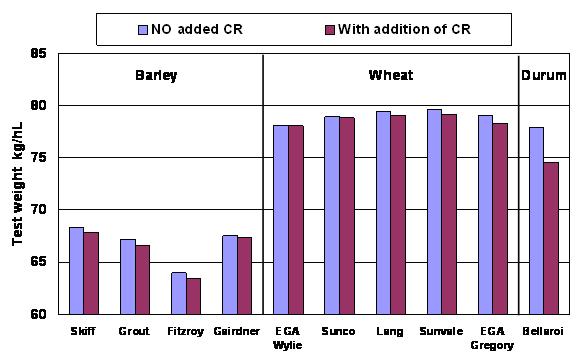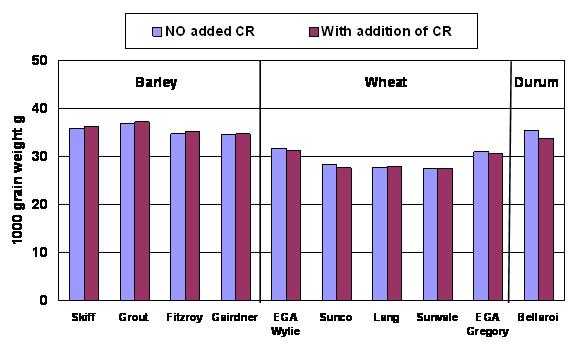THE IMPACT OF CROWN ROT ON WINTER CEREAL YIELDS - YEAR 2
| Date: 17 Sep 2009

GRDC codes
NGA00001: validation and integration of new technology through grower groups in north-west NSW and south-west Queensland grain growing zones
DAN00109: Management of Fusarium and other winter cereal diseases in the northern cropping zone
Background
This was the second year of a project attempting to answer a number of ongoing grower and adviser questions:
1. What level of affect does crown rot actually have on barley yield and how does that compare to the impact on bread and durum wheats?
2. How do Fitzroy and Grout compare to established barley varieties in the presence of crown rot?
3. How well do published wheat variety resistance ratings reflect yield losses under crown rot pressure (tolerance)?
NB Resistance is the ability to limit the development of the disease whilst tolerance is the ability to maintain yield in the presence of the disease. Published crown rot ratings are largely based on the evaluation of resistance.
What was compared?
In 2007 a collaborative model, between NGA and NSW DPI, was used to evaluate crop and variety performance over a wide range of conditions. The key comparison was that all varieties were evaluated with and without added crown rot at sites where crown rot was expected to be at low natural levels. This allowed an evaluation of the impact of crown rot on yield and grain quality, independent of other variables.
Seven small plot trials were conducted in 2008, six sites managed by NGA with an additional site at Tamworth managed by NSW DPI. There were four replicates in all trials. Equivalent counts of viable seeds per plot were sown for all treatments.
All barley, bread wheat and durum varieties tested in 2007 were re-evaluated together with Strzelecki and Ellison (two northern varieties with the poorest crown rot resistance ratings) and Jandaroi (a quicker maturing durum). The bread wheat varieties were primarily chosen to give a wide range of resistance rankings.
Table 1. Trial locations, planting and harvest dates
|
Location
|
Planting date
|
Harvest date
|
|
Goondiwindi
|
June 16
|
November 7
|
|
North Star
|
June 6
|
November 11
|
|
Bullarah
|
June 9
|
November 13
|
|
Cryon
|
May 14
|
November 6
|
|
Bellata
|
May 21
|
November 11
|
|
Gilgandra
|
May 20
|
November 14
|
|
Tamworth
|
June 10
|
December 3
|
Crown rot inoculum was applied at 2 grams/m row, as per the 2007 program. Samples for plant pathology assessment were collected by NSW DPI from all trials shortly prior to harvest with all trials harvested by small plot headers to attain grain yield and quality samples.
What level of affect did added crown rot have on crop yields?
Figure 1. % yield loss by crop 2007 & 2008
• The level of crown rot yield losses was minimal in 2008 trials. This highlights the impact of late seasonal conditions in determining the level of yield loss due to crown rot
• Yield loss in barley was similar to the loss in bread wheat
• Despite the favourable finish, durum losses were still concerning and more than triple the average loss in barley
• There was no clear pattern of yield loss difference within either the barley or wheat varieties, under the lower crown rot yield loss conditions in 2008
Actual yields 2007 & 2008 – grain in the bin!
Figure 2 highlights the average yields of the tested varieties 2008 (7 trials) and in 2007 (11 trials)
Figure 2. Actual yields by variety 2007 & 2008
NB Within each crop, varieties ranked in order (left to right) from highest to lowest for crown rot resistance rating (MR = moderately resistant, MS = moderately susceptible, S = susceptible, VS = very susceptible, courtesy NSW DPI winter crop variety sowing guide 2008)
• Grain yields in 2008 were more than double those achieved in 2007, reflecting the favourable season which reduced the impact of crown rot on yield
• Variety performance trends were similar over both seasons other than for EGA Wylie which recorded poor yields at three sites in 2008 where stripe rust pressure was high
Grain quality
2008 grain quality samples are still to be analysed however Figures 3, 4 and 5 show the impact of crown rot on test weight, 1000 grain weight and screenings in 2007, a season with higher yield loss from crown rot. 
Figure 3. Test weight by variety 2007
• Even under high yield loss, crown rot had little impact on barley or wheat test weight
• Crown rot resulted in an average 3 kg/hL reduction in test weight in Bellaroi 
Figure 4. 1000 grain weight by variety 2007
• Even under high yield loss, crown rot had little impact on barley or wheat individual grain weight
• The durum was more affected than barley or bread wheat 
Figure 5. Screenings by variety 2007
• Screenings showed the biggest grain quality impact from the addition of crown rot
• There was little impact in barley
• There was a mean increase in screenings of ~4% across all tested wheat varieties (range 2-6%).
• The impact on durum was more dramatic with significant increases in screening levels in all trials with a mean increase of ~13%
• The crown rot impact on screenings resulted in grain quality downgrades in ~40% of bread wheat and 75% of durum comparisons.
Commercial implications (when crown rot added)
The economic data provided below is purely based on yield assuming equal grain prices for each variety.
Barley
Figure 6. Barley net returns compared to Skiff +CR, 2007 & 2008
Assuming 2007 grain price of $310/t on-farm, 2008 grain price of $125/t on-farm.
Skiff was used as the standard due to wide adaptation and consistency of yield performance
• There were only small net return differences between all varieties in both years
• Inherent variety yield and other agronomic characteristics have influenced final yield more than crown rot resistance eg in high crown rot loss situations, Grout lost 1-4% more yield than the other barley varieties (it may be marginally less tolerant) but still recorded the highest mean yield
Wheat
Figure 7. Wheat net returns compared to Sunco + CR, 2007 & 2008
Assuming 2007 grain price of $375/t on-farm, 2008 grain price of $206/t on-farm.
Sunco has been the benchmark variety for crown rot resistance for many years
• All four varieties tested in both years provided a net benefit compared to Sunco BOTH with or without added crown rot
• These results do NOT indicate all four varieties are more resistant or tolerant to crown rot than Sunco but rather that the differences in tolerance measured have been small and outweighed by inherent variety yield eg under high loss situations in 2007, EGA Gregory lost a higher % yield to crown rot than the other varieties but still recorded the second highest final yields in the presence of added crown rot
Conclusions
Barley
1. The tested varieties suffered similar levels of crown rot % yield loss (tolerance) to the bread wheat varieties in both years
2. Fitzroy and Grout recorded similar yield losses to Skiff and Gairdner , when subjected to crown rot pressure
3. Despite high yield losses from the addition of crown rot in 2007, barley grain quality was not affected. This may explain why barley has generally been thought to be more tolerant of crown rot than wheat. In a commercial field there is no ability to measure the yield loss due to crown rot, whilst the harvested grain quality would not suggest any disease impact. Crown rot in barley – the silent thief.
4. Barley should NOT be considered as a less risky rotation option than bread wheat for higher crown rot risk situations
Wheat
1. Current bread wheat varieties only have, at best, partial resistance to crown rot
2. Evaluated varieties showed minor differences in % yield loss (tolerance) under crown rot pressure. In 2007, even in situations where average yield losses due to crown rot in bread wheat were ~50% or more, there was only a 10-15% difference in yield loss between the worst and best performing wheat variety
3. Whilst varieties only have partial resistance to crown rot, other agronomic characteristics may be more important in determining final yield than the crown rot resistance rating
4. In 2007, halving the inoculum rate in Lang reduced yield loss due to crown rot by between 11-20%. Halving the inoculum load is likely to provide more benefit than changing from the worst to best crown rot variety. Rotation therefore remains the most important component in the integrated management of this disease
Durum
1. Yield losses were greater than in barley and bread wheat in nearly every situation
2. Despite quicker maturity, Jandaroi does not appear to offer any crown rot disease management benefit compared to Bellaroi
General
A total of 235 stubble samples were tested for crown rot inoculum levels prior to sowing in 2007 through Crown Analytical Services or Healthy Soils Workshops. Samples were either from random paddocks, expected low risk or unknown risk situations. Plating revealed that 66% of paddocks had low CR risk, 16% medium risk and 18% high CR risk. This demonstrates the value in accurately knowing the crown rot risk within paddocks. This will be critical for sowings in 2009 as favourable seasonal conditions in 2008 limited the expression of whiteheads thus potentially masking the true inoculum levels built-up in last year’s cereal crops. The good conditions also generally produced bigger crops hence the stubble loads carried into 2009 will be greater. Even with lower infection levels these higher stubble loads may translate into significant CR inoculum levels in 2009.
Acknowledgements
Thanks to the many growers and consultants involved in this trial work, the support and advice of Steven Simpfendorfer and his pathology team and Clare Felton-Taylor for field co-ordination.
Contact details
|
Richard Daniel
Northern Grower Alliance
Ph: 07 4639 5344
Email: richard.daniel@nga.org.au
|
Steven Simpfendorfer
NSW DPI Tamworth
Ph: 02 6763 1261
Email: steven.simpfendorfer@dpi.nsw.gov.au
|
Varieties displaying this symbol beside them are protected under the Plant Breeders Rights Act 1994.
Was this page helpful?
YOUR FEEDBACK


